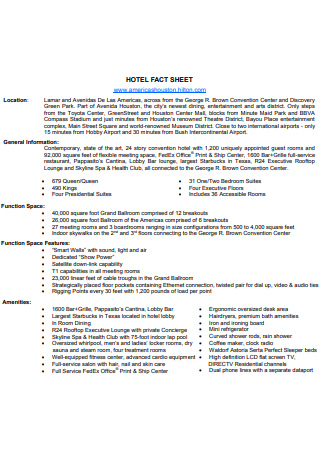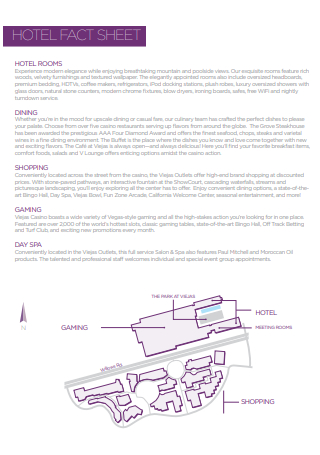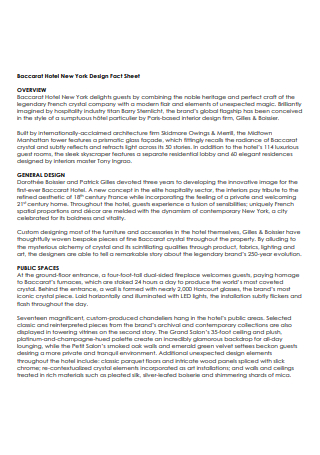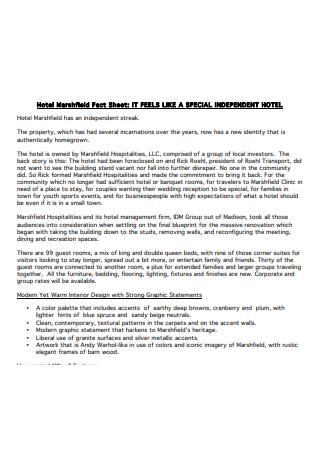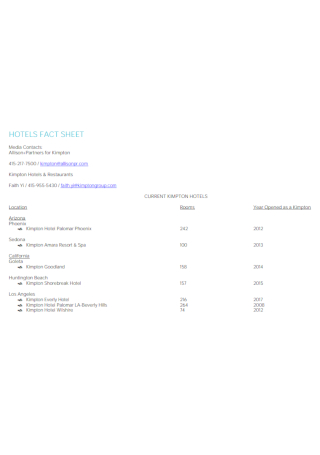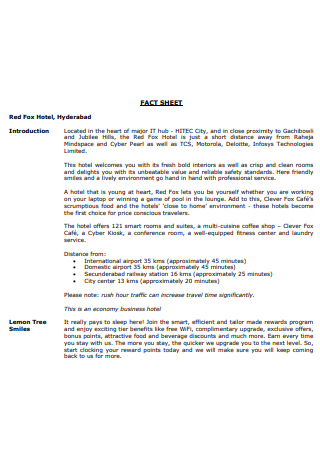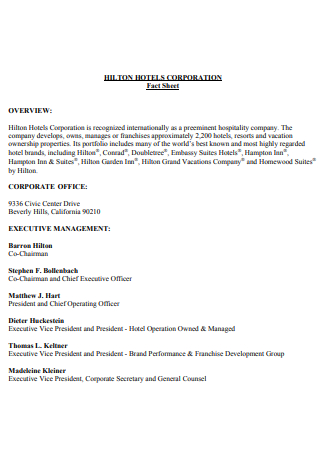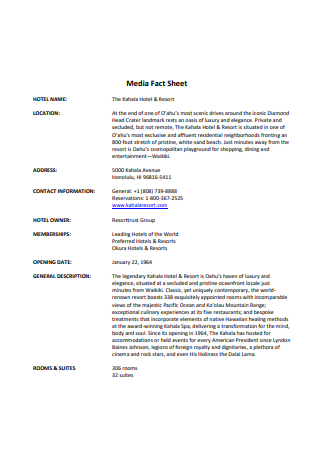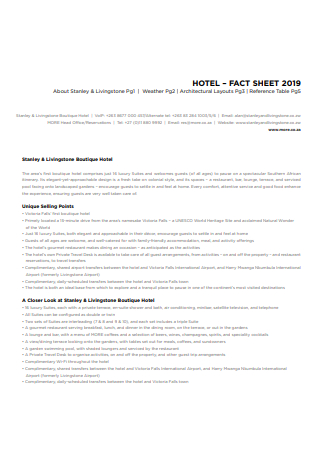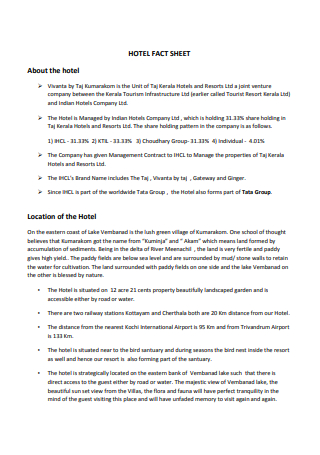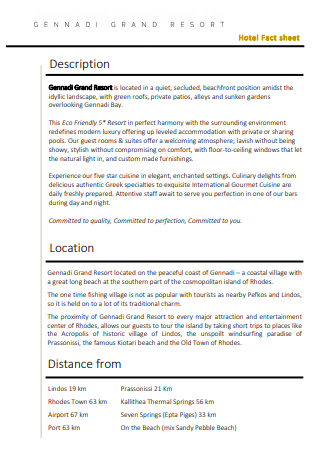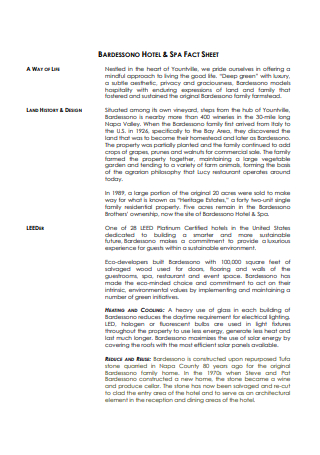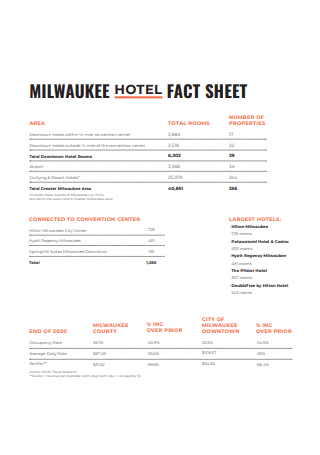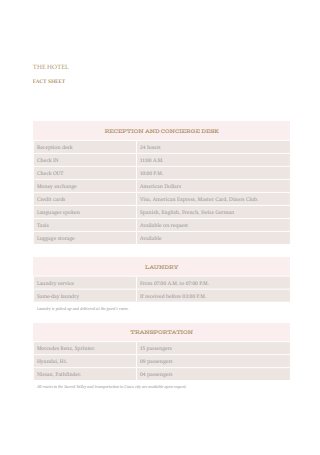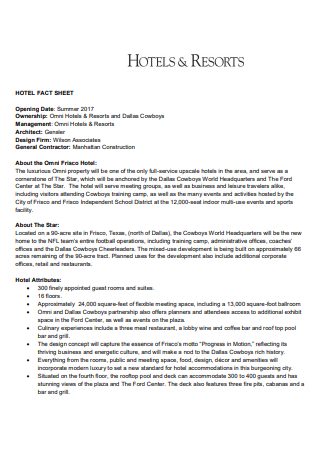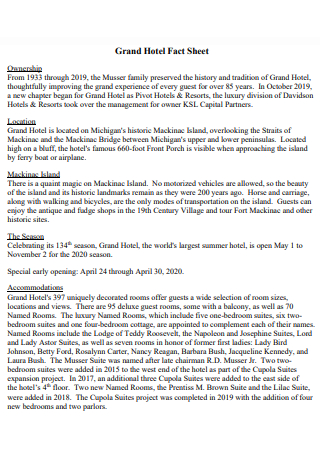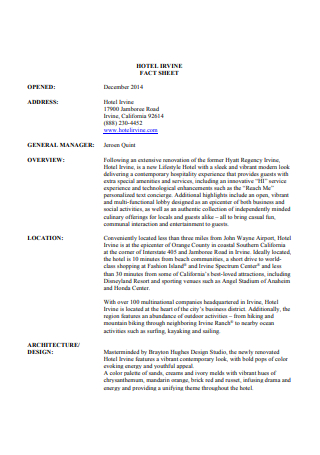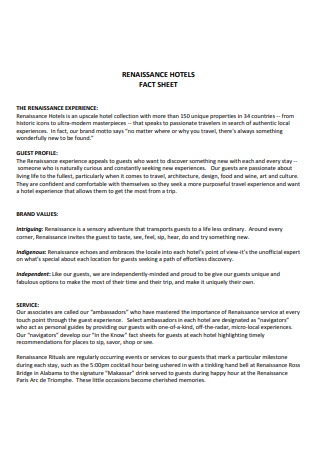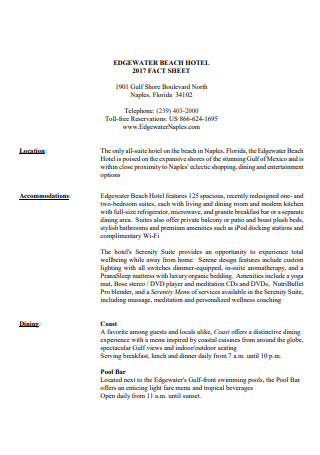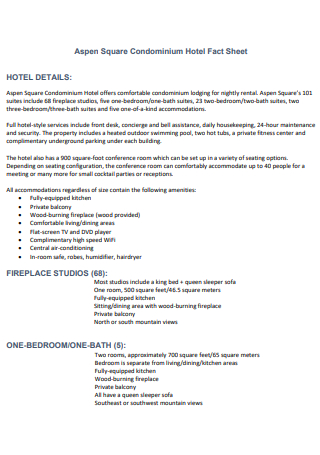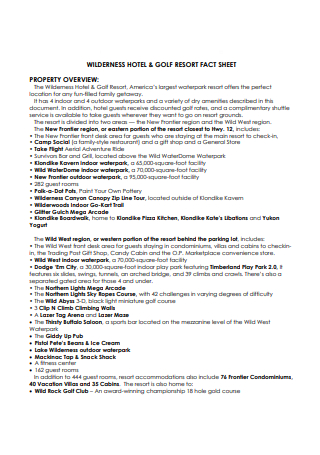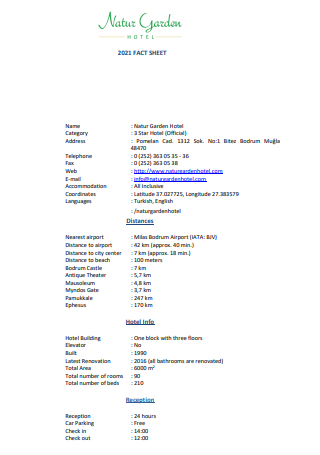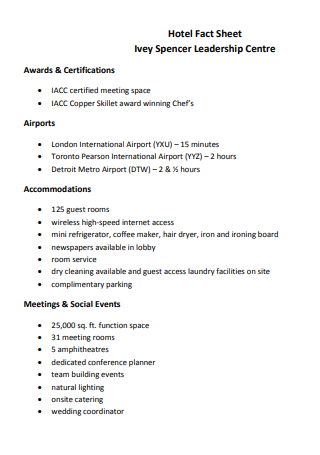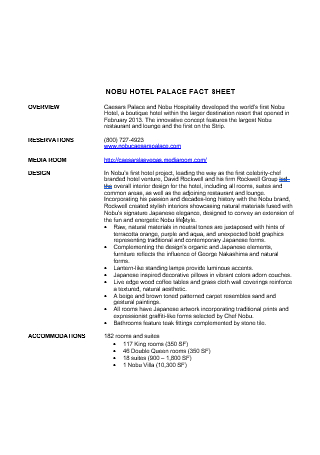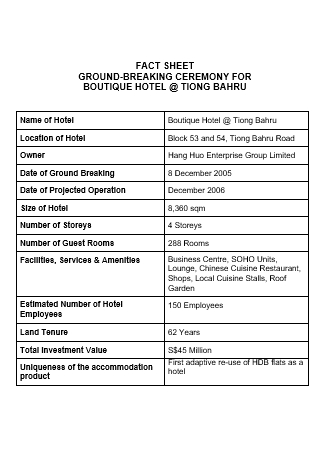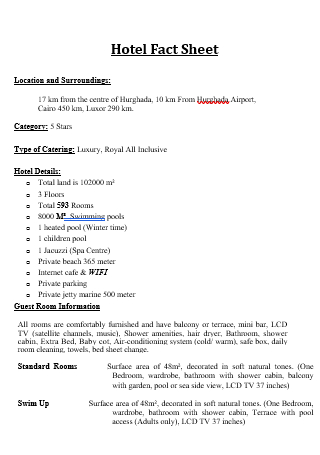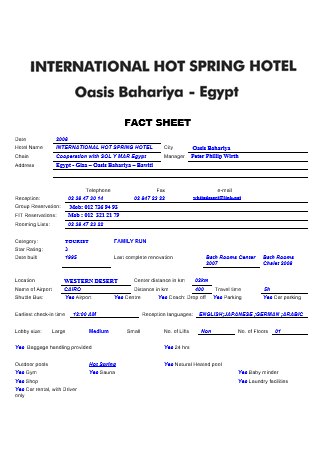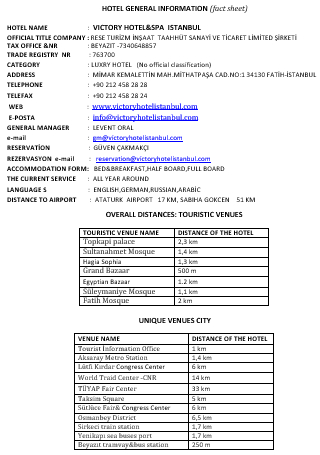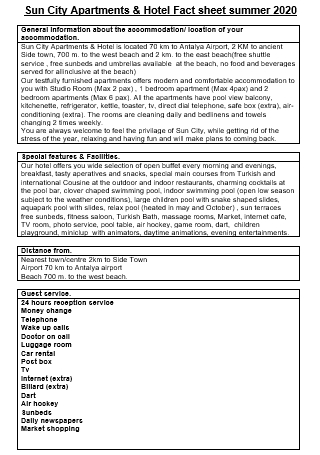34+ Sample Hotel Fact Sheet
FREE Hotel Fact Sheet s to Download
What Is a Hotel Fact Sheet?
A hotel fact sheet is a quick rundown of essential information about a hotel. It can be used simultaneously as an educational and promotional material. It is usually a condensed document, containing no more than a page or two.
According to an article by EHL Insights, the hospitality industry accounts for almost 10% of the worldwide GDP. But due to the COVID-19 pandemic, the impact on the industry’s labor force seems less than promising. The World Travel and Tourism Council expects around 50 million jobs to be cut due to the current health and economic crisis.
Components of a Hotel Fact Sheet
Deciding on the contents of a hotel fact sheet would depend on the company itself. Some well-established hotels keep it short but detailed with bullet points and relevant images. Other hotels prefer to give a more general overview rather than specific points. The examples listed below are some common components you can find in most hotel fact sheets:
Brief Background: Like any company fact sheet, a quick company overview or background serves as an introduction. It is best to keep it short and general by only highlighting the important facts. A fact sheet typically comes with limited space that you need to strategically maximize, so one or two paragraphs would be enough for this section. History or Timeline: Some hotels, especially the more established ones, provide a detailed timeline of the hotel’s history and milestones. This section is optional. But if you do choose to include one, you can organize it in such a way that it won’t take up too much space given the already limited space on the fact sheet. Indicate the years and arrange your timeline in chronological order for a seamless flow of events. Amenities and Facilities: This is one of the most fundamental parts of a hotel fact sheet. All hotels should enumerate their amenities. For customers and hotel guests, this is vital information and it helps them manage their expectations. Hoteliers should be able to anticipate the needs of guests and clients. For example, a guest could wonder if there is an indoor gym at the hotel. Make sure to include this in your list of amenities and facilities. Further, do not discount the importance of figures. Provide numbers and figures so guests will have a concrete idea. You can list down the total number of guest rooms and the number of conference rooms, banquet halls, or ballrooms the hotel has. Nearby Attractions: This can be vital information for a visiting tourist. The same logic for the amenities applies here. Try placing yourself in your guest’s shoes and anticipate any demands or needs they may have. If they are first-time visitors, you may want to suggest interesting landmarks for them to visit or good places to eat. You may also want to include helpful information like where the nearest train station or transport hub is. Guests could also need advice or tips on the nearest convenience stores or shopping malls. Recommending nearby attractions is one way of exerting extra effort for your hotel guest. Achievements: This section is not exclusively for bragging but instead, highlighting your hotel’s accomplishments. Due recognition can add credibility and set high standards or expectations that would make your guests more confident in their choice of accommodation. Especially now in the age of online reviews and guest ratings, customer satisfaction and feedback matter even more. Like any promotional material, playing up one’s strengths is common and universally accepted. So if you took home the award for ‘Best Luxury Hotel’ last year, there’s no shame in inserting that in your fact sheet. Services: Aside from amenities, it would be good to inform guests and customers about available services that your hotel offers. These services could include dry cleaning and laundry service, 24-hour security, daily room service, shuttle service or rental, airport transfers, guided tours or customized itineraries, members reward program, pet grooming, business center for printing and office needs, etc. List them down in an organized way using clear bullet points. Again, this key information is primarily to anticipate a guest’s needs. Visitors would appreciate the thought if they did not have to ask for a list of available services. Other Locations: This may not apply to all hotels, but established commercial hotels often include brief descriptions of their other locations. Especially if the company operates a chain of hotels around the world, it would be good to specify other brands under the same company. This also gives the guest the impression that your hotel brand is an internationally recognized and trusted brand of service. Guestroom Details: Many commercial hotels have different kinds of rooms and rarely stick to one type of room. Typical rooms include superior, deluxe, family rooms, presidential suites, honeymoon suites, and so many others that go by different names. For resorts, a guest can rent out an entire villa with their own exclusive pool. These are important details to list down in booking reservation websites, but it can also be incorporated in your hotel fact sheet. Use bullet points to enumerate various details such as room size and room amenities (e.g., flat screen TV, coffeemaker, hairdryer, etc.). High Resolution Images: Aside from detailed information, you want your hotel fact sheet to be visually appealing as well. A comprehensive and informative fact sheet would seem empty or lacking without the right photos to back it up. Make sure these are tasteful, clear, and high quality images. Where you place them in your fact sheet is crucial as well. You want your photos arranged and strategically placed in order to create a coherent and attractive hotel fact sheet. Contact Information and Reservation Process: A fact sheet needs basic facts, obviously. And these include official hotel information such as the complete address, contact numbers, fax number, email address, official website, and even links to social media pages. Ensure that all contact information is working and active. In addition to this, providing a direct line for booking and reservations will make it more convenient for potential customers. An official booking email address and phone number should be listed. You could also include the name of the person-in-charge of booking such as a front desk or reservations officer. Map: This component is optional but could serve as additional information for stay-in guests. Depending on how much space is allotted for other sections of your hotel fact sheet, you may also want to insert a small map to give customers a general idea of your exact location. This is particularly useful for business hotels located within central business districts (CBD). Big cities are usually sprawling with various streets and intersecting roads. For the first-time visitor, it could be confusing and challenging to get around. So providing a map could prove useful to your guest.
Types of Hotels
In recent decades, there have been various types of accommodations sprouting up and gaining popularity. With the increasing ease and convenience of travel, more and more people are becoming mobile. In other words, more people are taking the opportunity to travel. And together with this booming travel and tourism industry, the hospitality sector has grown alongside with it. From capsule hotels to global hotel chains, the industry has adapted to serve not just a particular market but a diverse group of customers. The following examples listed below are just some common types of hotels that cater to different kinds of people:
Luxury Hotel: Luxury hotels are expectedly big and grand. Like the name suggests, you can usually expect world class service and expensive price tags for these types of hotels. Otherwise known as five-star hotels, they are known for selling opulence and luxury. It could be state-of-the-art guestrooms, extravagant ballrooms, indulgent spas, world class restaurants, or scenic views. Many luxury hotels are global, multinational chains as well. Their brand and service are all about setting high standards and exceeding guest expectations. Business Hotel: Business hotels are smaller in scale compared to luxury hotels. And these are mainly for the purpose of work and official business. A typical business hotel is strategically located in a central business district or CBD, where modern conveniences and amenities are within close range for busy guests who rarely have the luxury of time. These types of hotels house several conference rooms, boardrooms, or meeting rooms for companies to hold various events like seminars, workshops, training, etc. Hostel or Inn: Hostels are quite popular with younger, budget-minded travelers. A hostel, inn or even a motel are obviously more economical compared to luxury hotels. These budget-friendly accommodations are for practical travelers who only require what is essential. Some hostels even have communal bathrooms with a dormitory-style arrangement. Backpacking travelers who hop from one country to another typically stay in small hostels and inns because they are not heavy on the budget. These days, however, a lot of hostels are incorporating their own twist to attract more travelers and tourists. Whether it’s a themed hotel or an eco-friendly hostel, these hotels prove that creativity does need to come with an expensive price tag. Boutique Hotel: A boutique hotel prides itself in its uniqueness and eccentricity. Unlike typical chain hotels, these types of hotels focus less on quantity and tend to care more about quality. Some would say that boutique hotels are more intentional when it comes to their brand and look. Whether that focus be on the hotel’s architecture, interior design, or even personalized service, a boutique hotel strives to set itself apart from the rest.
How to Create a Hotel Fact Sheet
To create a useful, informative, and appealing hotel fact sheet, use any of the available sample templates above. You can use it as a helpful guide and easily customize it to your liking. Follow the quick step-by-step guide below to get started.
Step 1: Provide the Right Information
A hotel fact sheet should not just contain key hotel information, but accurate information as well. Arrange and organize your information accordingly; you can get ideas from the example components found above. Your hotel fact sheet should contain a general background on the hotel, a list of amenities and services, contact and location details, among others. If you are concerned about organization, it might be a good idea to arrange all your information in bullet points.
Step 2: Decide on the Proper Layout
You want your hotel fact sheet to be attractive and organized. This requires a strategic layout. Even if your information is solid and helpful, if your layout fails to serve as the proper vehicle for your information then it would fall short of being impactful. Decide on a layout that can best highlight the information on your hotel fact sheet. You can use bullet points and other strategic methods to create a more organized and coherent fact sheet. Mind your spacing and placing of images as well.
Step 3: Come Up with an Attractive Design
Having the right information may not be enough. Come up with an attractive and appealing design to complement your information. Make sure your design and graphics are aligned with your brand. Design consists of the overall look and appeal of the fact sheet. The choice of color palette and font style are all part of design. Use only high quality imagery and ensure that text is legible enough to read.
Step 4: Supplement with an Active Marketing Campaign
The last step is optional but it is highly encouraged because a fact sheet may simply be an information tool, but it can also be used as a potent promotional tool. And promotions usually entail marketing strategies. To drive your sales and hotel occupancy, you cannot simply be passive about promotions. Taking a proactive role in marketing and information dissemination can reap potential benefits.
FAQs
What is a hotel fact sheet?
A hotel fact sheet is an informative document that provides a general overview about a hotel’s location, amenities, services, etc.
What should be included in a hotel fact sheet?
It should include a brief background, list of facilities and services, contact information, etc. You have the option to include accomplishments, key people in the organization, and a timeline of the hotel’s history.
What is a basic fact sheet?
Ideally, a fact sheet should just be a brief overview of a company or hotel. A one-page fact sheet would do.
A hotel fact sheet should be informative and visually appealing at the same time. The diverse templates above can help you personalize your own fact sheet. Browse, download, then create your own hotel fact sheet now!
